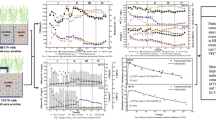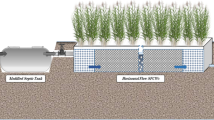Abstract
Stormwater treatment requires effective control measures and development of low-cost and high-efficiency technologies. An integrated system is developed by combining a baffled vertical-flow constructed wetland (BVFCW) and a scenic water body for stormwater quality control purpose. The objectives of the study are to compare the pollutant removal performance of the full-scale integrated system with four groups of wetland-to-scenic water body area ratios (WSARs) including 1/11, 2/11, 3/11, 4/11 and investigate its treatment efficiency. Results show that the system performs better in the removal of chemical oxygen demand (COD), total nitrogen (TN), ammonia nitrogen (NH4+–N), nitrate-nitrogen (NO3–N), and total phosphorus (TP) at the WSAR of 4/11 than that at 3/11 in sixteen-day operation, while it reaches the highest total nitrogen (TN) removal efficiency of 74.0% at the WSAR of 2/11 due to relatively rich carbon source and high influent TN concentration. The integrated system may prove the most effective COD removal at the WSAR of 4/11 for four-time aerobic/anaerobic alternating conditions, a longer flow path and more time to contact with substrates, although the influent COD is lower than that at 2/11 and 1/11. After sixteen-day operation, BVFCW achieved COD removal rate of 90.3%, NH4+–N removal rate of 85.7%, NO3–N removal rate of 68.6%, and TP removal rate of 52.5% at the WSAR of 4/11. At the WSAR of 1/11, effluent met the Class IV requirements in Chinese standards after one-week operation, while effluent met the Class III requirements under the rest conditions. Since effluent in all WSARs met the standards, WSARs of 1/11 and 2/11 were recommended.













Similar content being viewed by others
References
Adyel TM, Oldham CE, Hipsey MR (2016) Stormwater nutrient attenuation in a constructed wetland with alternating surface and subsurface flow pathways: event to annual dynamics. Water Res 107:66–82
APHA (2005) Standard methods for the examination of water and wastewater. American Public Health Association (APHA), Washington, DC
Avila C, Matamoros V, Reyescontreras C, Piña B, Casado M, Mita L et al (2014) Attenuation of emerging organic contaminants in a hybrid constructed wetland system under different hydraulic loading rates and their associated toxicological effects in wastewater. Sci Total Environ 470-471(2):1272–1280
Cairns J, Palmer SE (1995) Restoration of urban waterways and vacant areas: the first steps toward sustainability. Environ Health Perspect 103(5):452–453
Calero S, Segura M, Rojo C, Rodrigo MA (2015) Shifts in plankton assemblages promoted by free water surface constructed wetlands and their implications in eutrophication remediation. Ecol Eng 74(74):385–393
Cao W, Wang Y, Sun L, Jiang J, Zhang Y (2016) Removal of nitrogenous compounds from polluted river water by floating constructed wetlands using rice straw and ceramsite as substrates under low temperature conditions. Ecol Eng 88:77–81
Chai H, Gong H, Shen S, Li S, Zou B, Li L, et al (2014). Integrated system for treating and recycling rainwater. US 20140124424 A1
Chen X, Huang X, He S, Yu X, Sun M, Wang X, Kong H (2013) Pilot-scale study on preserving eutrophic landscape pond water with a combined recycling purification system. Ecol Eng 61(19):383–389
Chen H, Ivanoff D, Pietro K (2015) Long-term phosphorus removal in the everglades stormwater treatment areas of South Florida in the United States. Ecol Eng 79:158–168
Conn RM, Fiedler FR (2006) Increasing hydraulic residence time in constructed stormwater treatment wetlands with designed bottom topography. Water Environ Res 78(13):2514–2523
Du L, Trinh X, Chen Q, Wang C, Wang H, Xia X et al (2017) Enhancement of microbial nitrogen removal pathway by vegetation in integrated vertical-flow constructed wetlands (ivcws) for treating reclaimed water. Bioresour Technol 249:644
Fan J, Zhang B, Zhang J, Ngo HH, Guo W, Liu F, Guo Y, Wu H (2013) Intermittent aeration strategy to enhance organics and nitrogen removal in subsurface flow constructed wetlands. Bioresour Technol 141:117–122
Hua G, Kong J, Ji Y, Li M (2017) Influence of clogging and resting processes on flow patterns in vertical flow constructed wetlands. Sci Total Environ
Hughes RM, Dunham S, Maas-Hebner KG, Yeakley JA, Schreck C, Harte M, Molina N, Shock CC, Kaczynski VW, Schaeffer J (2014) A review of urban water body challenges and approaches: (1) rehabilitation and remediation. Fisheries 39(1):18–29
Khiadani HM, Zarrabi M, Foroughi M (2013) Urban runoff treatment using nano-sized iron oxide coated sand with and without magnetic field applying. J Environ Health Sci Eng 11(1):43
Knowles PR, Griffin P, Davies PA (2010) Complementary methods to investigate the development of clogging within a horizontal sub-surface flow tertiary treatment wetland. Water Res 44(1):320–330
Land M, Granéli W, Grimvall A, Hoffmann CC, Mitsch WJ, Tonderski KS et al (2013) How effective are created or restored freshwater wetlands for nitrogen and phosphorus removal: a systematic review protocol. Environ Evid 2(1):16
Li A, Gai Z, Cui D, Ma F, Yang J, Zhang X, Sun Y, Ren N (2012) Genome sequence of a highly efficient aerobic denitrifying bacterium, pseudomonas stutzeri t13. J Bacteriol 194(20):5720–5720
Li F, Lu L, Zheng X, Ngo HH, Liang S, Guo W, Zhang X (2014) Enhanced nitrogen removal in constructed wetlands: effects of dissolved oxygen and step-feeding. Bioresour Technol 169(5):395–402
Li H, Chi Z, Yan B, Cheng L, Li J (2016) Nitrogen removal in wood chip combined substrate baffled subsurface-flow constructed wetlands: impact of matrix arrangement and intermittent aeration. Environ Sci Pollut Res Int 24(5):1–7
Lian L, Revitt M, Ellis B (2017) An impact assessment for urban stormwater use. Environ Sci Pollut Res Int 3:1–12
Lin YF, Jing SR, Lee DY, Chang YF, Chen YM, Shih KC (2005) Performance of a constructed wetland treating intensive shrimp aquaculture wastewater under high hydraulic loading rate. Environ Pollut 134(3):411–421
Lucas R, Babatunde AO (2017) Influence of key design and operating variables on dynamics of pollutant removal in experimental stormwater constructed wetlands. J Environ Eng 143(7):04017015
Ma F, Sun Y, Li A, Zhang X, Yang J (2015) Activation of accumulated nitrite reduction by immobilized pseudomonas stutzeri, t13 during aerobic denitrification. Bioresour Technol 187:30–36
Maltais-Landry G, Maranger R, Brisson J, Chazarenc F (2009) Nitrogen transformations and retention in planted and artificially aerated constructed wetlands. Water Res 43:535–545
Matamoros V, Salvadã V (2012) Evaluation of the seasonal performance of a water reclamation pond-constructed wetland system for removing emerging contaminants. Chemosphere 86(2):111–117
Moortel AMKVD, Meers E, Pauw ND, Tack FMG (2010) Effects of vegetation, season and temperature on the removal of pollutants in experimental floating treatment wetlands. Water Air Soil Pollut 212(1–4):281–297
Nguyen XC, Chang SW, Nguyen TL, Ngo HH, Kumar G, Banu JR et al (2018) A hybrid constructed wetland for organic-material and nutrient removal from sewage: process performance and multi-kinetic models. J Environ Manag 101:378–384
Nie M et al (2001) The technical assessment handbook for ecological residence of China. China Architecture& Building Press
Olguín EJ, Sánchez-Galván G, Melo FJ, Hernández VJ, González-Portela RE (2017) Long-term assessment at field scale of floating treatment wetlands for improvement of water quality and provision of ecosystem services in a eutrophic urban pond. Sci Total Environ 584–585:561–571
Rooney RC, Carli C, Bayley SE (2013) River connectivity affects submerged and floating aquatic vegetation in floodplain wetlands. Wetlands 33(6):1165–1177
Saeed T, Sun G (2012) A review on nitrogen and organics removal mechanisms in subsurface flow constructed wetlands: dependency on environmental parameters, operating conditions and supporting media. J Environ Manag 112(24):429–448
Samsó R, Garcia J (2013) Bio_pore, a mathematical model to simulate biofilm growth and water quality improvement in porous media: application and calibration for constructed wetlands. Ecol Eng 54(54):116–127
SEPA (2002) Chinese environmental quality standards for surface water (GB3838-2002). State Environmental Protection Administration of China (SEPA), Bei Jing
Sun Y, Feng L, Li A, Zhang X, Yang J, Ma F (2017) Ammonium assimilation: an important accessory during aerobic denitrification of pseudomonas stutzeri t13. Bioresour Technol 234:264–272
Tanner CC, Kadlec RH (2003) Oxygen flux implications of observed nitrogen removal rates in subsurface-flow treatment wetlands. Water Sci Technol 48(5):191–198
Tee HC, Lim PE, Seng CE, Nawi MA (2012) Newly developed baffled subsurface-flow constructed wetland for the enhancement of nitrogen removal. Bioresour Technol 104(1):235–242
Thongtha S, Teamkao P, Boonapatcharoen N, Tripetchkul S, Techkarnjararuk S, Thiravetyan P (2014) Phosphorus removal from domestic wastewater by nelumbo nucifera, gaertn, and Cyperus alternifolius. J Environ Manag 137(4):54
USEPA (2004) The use of best management practices (BMPs) in urban watersheds. EPA, Cincinnati
Vohla C, Kõiv M, Bavor HJ, Chazarenc F, Mander Ü (2011) Filter materials for phosphorus removal from wastewater in treatment wetlands—a review. Ecol Eng 37(1):70–89
Walaszek M, Bois P, Laurent J, Lenormand E, Wanko A (2018) Urban stormwater treatment by a constructed wetland: seasonality impacts on hydraulic efficiency, physico-chemical behavior and heavy metal occurrence. Sci Total Environ 637-638:443–454
Wei T, Wijesiri B, Jia Z, Li Y, Goonetilleke A (2018) Re-thinking classical mechanistic model for pollutant build-up on urban impervious surfaces. Sci Total Environ 651(Pt 1):114–121
Weiss PT, Asce M, Gulliver JS, Asce F, Erickson AJ, Asce SM (2007) Cost and pollutant removal of storm-water treatment practices. J Water Resour Plan Manag 133(3):218–229
Wosiack PA, Lopes DD, Damianovic MHRZ et al (2015) Removal of COD and nitrogen from animal food plant wastewater in an intermittently-aerated structured-bed reactor. J Environ Manag 154:145–150
Xie H, Yang Y, Liu J, Kang Y, Zhang J, Hu Z, Liang S (2018) Enhanced triclosan and nutrient removal performance in vertical up-flow constructed wetlands with manganese oxides. Water Res 143:457–466
Yahoo Maps (2018) Access: September, 2018. Available at: https://maps.yahoo.com/beta
Yan Y, Xu J (2014) Improving winter performance of constructed wetlands for wastewater treatment in northern China: a review. Wetlands 34:243–253
Zare SO, Saghafian B, Shamsai A (2012) Multi-objective optimization for combined quality–quantity urban runoff control. Hydrol Earth Syst Sci 16(12):4531–4542
Zhao F, Xi S, Yang X, Yang W, Li J, Gu B, He Z (2012) Purifying eutrophic river waters with integrated floating island systems. Ecol Eng 40(3):53–60
Zhong F, Wu J, Dai Y et al (2015) Bacterial community analysis by PCRDGGE and 454-pyrosequencing of horizontal subsurface flow constructed wetlands with front aeration. Appl Microbiol Biotechnol 99:1499–1512
Acknowledgments
We thank the other members of our group, who gave us advice and suggestions regarding this work, for their selfless contributions.
Funding
This work was financially supported by the National Science and Technology Major Project for Water Pollution Control and Remediation of China: Storm-water Management for Green Infrastructure and Low Impact Development Research and Demonstration Project (Grant No. 2010ZX07320-001), and the National Key R&D program of China (Grant 2017YFC0404704).
Author information
Authors and Affiliations
Corresponding author
Additional information
Responsible editor: Philippe Garrigues
Rights and permissions
About this article
Cite this article
Chai, H., Li, W., Shao, Z. et al. Pollutant removal performance of an integrated system that combines a baffled vertical-flow wetland and a scenic water body. Environ Sci Pollut Res 26, 269–281 (2019). https://doi.org/10.1007/s11356-018-3507-8
Received:
Accepted:
Published:
Issue Date:
DOI: https://doi.org/10.1007/s11356-018-3507-8




